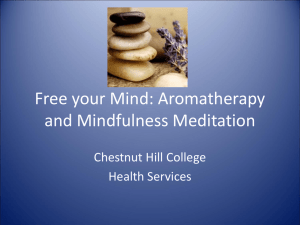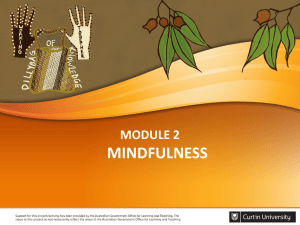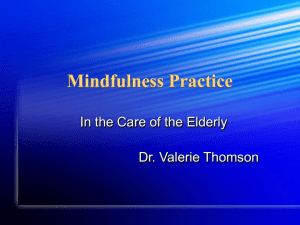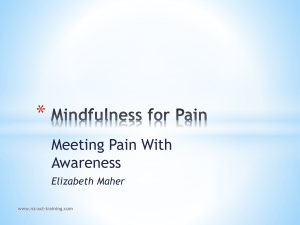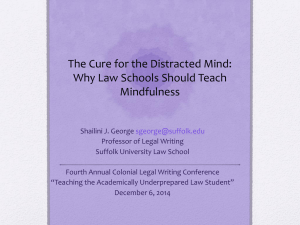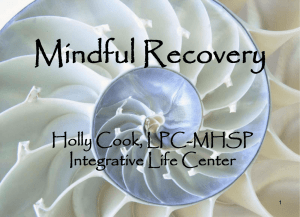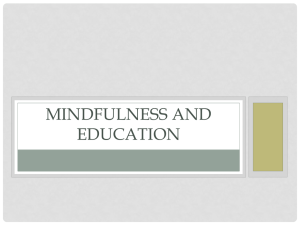Mindful Strategies - St. Cloud State University
advertisement
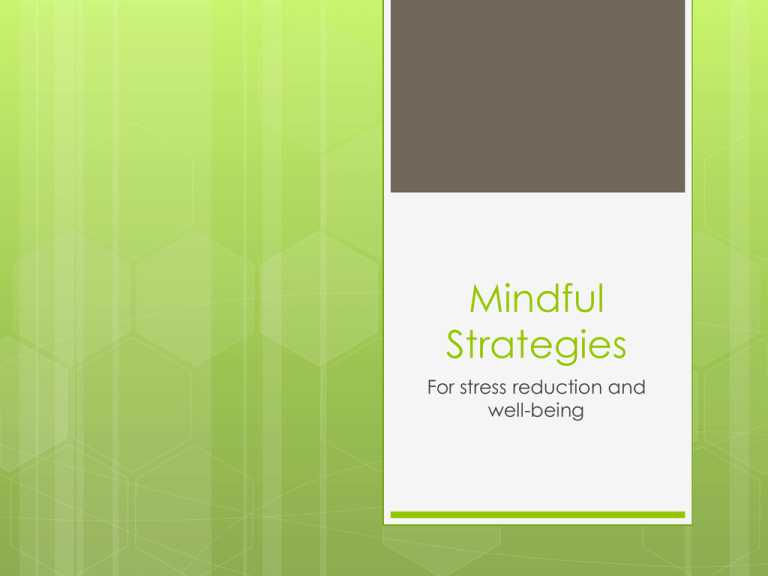
Mindful Strategies For stress reduction and well-being Why Mindfulness, Why Now? Growing research base supporting the physical, psychological and emotional benefits to mindfulness & meditation. Challenges of a 24/7/365 life. Desire to take back aspects of our lives. Search for meaning and significance. To be more present to the world, those around us and to ourselves. Thoreau Only that day dawns to which we are truly awake. Body Scan Meditation When it is effective: Morning upon waking During the day in times of stress After a strenuous workout NOT at 6:30 pm? Mindfulness as a Component of Comprehensive Well-Being Career Well-Being Social Well-Being Financial Well-Being Physical Well-Being Community Well-Being Spiritual Well-Being Psychological Well-Being What is Mindfulness? Palmer: The most practical thing we can achieve in any kind of work is insight into what is happening inside of us as we do it. The more familiar we are with our own inner terrain, the more surefooted our teaching – and living - becomes. Kabat-Zinn “…awareness that arises through paying attention, on purpose in the present moment, non-judgmentally.” Kabat-Zinn “…mindfulness is the aim, the methods or practices, and the outcomes or consequences all wrapped up together, wholly fitting for a non-dual orientation that emphasizes nowhere to go, nothing to do, and nothing to attain.” Conscious intention to move from Human Doing to Human Being. Don’t Just Do Something – Sit There! Sitting Meditation MEDITATION: Its NOT what you THINK Meditation is best conceived as a set of practices designed to help us become more mindful, more aware, more present to ourselves, our loved ones, our students/clients/customers/friends, and our world. Meditation is a map, but the map is not the terrain. The Three Categories of Mindfulness Practice Formal mindfulness/meditation (ex.): Body Scan meditation Sitting Meditation – breath, sounds, objects, open awareness Walking meditation Movement/yoga meditation Eating meditation Others…. The Three Categories of Mindfulness Practice Informal mindfulness/meditation Strategies for moving from our mats/cushions into our lives. Mindful moments The Three Categories of Mindfulness Practice Formal Meditation Retreats What Mindfulness Meditation IS and IS NOT Not having a blank mind or stopping all thoughts from showing up. Mindfulness practices help us see our thoughts and mind more clearly. Not about seeking blissful states. Mindfulness practices help us accept all of our experiences instead of just clinging to those we enjoy and avoiding those we dislike. What Mindfulness Meditation IS and IS NOT Not Mindfulness practice enables us to more fully bear a full range of emotional experiences. Not becoming emotionless. withdrawing from life. Mindfulness practice attunes us to others, assists us to become more compassionate. What Mindfulness Meditation IS and IS NOT Not Mindfulness practice helps us recognize our pains, sufferings and dis-eases and allows us to embrace them. Not about escaping pain. about converting to a new religion. Mindfulness practices can support our efforts in any spiritual or psychological condition. Eating Meditation Seven Foundational Attitudes (Kabat-Zinn) Non-judging – being a witness to your experiences Patience – Sometimes things must unfold in their own time. Beginner’s Mind – Too often our mental constructs, our propensity to attach value get in the way of simply experiencing. Seven Foundational Attitudes Trust – in your inherent wisdom and goodness and your feelings. Non-Striving – there is no goal other than to be here, now, in the present moment with whatever arises. Acceptance – seeing things as they are in the present moment. Letting Go or Non-Attachment – metaphors for letting thoughts go. What are my intentions? Why am I hear? Curiosity Free food/ Free Session (100% Money Back Guarantee) Alleviate stress in my life – do you know what I have been going through lately with the kids, my spouse, the idiot boss at work… Learn some ways to become more present For some time away from everyone else I’m actually in the wrong room, but too embarrassed to get up and leave To find enlightenment Hindrances to a Regular Formal Practice Time Meditation – yet one more thing to feel guilty about NOT DOING Add it to my checklist of 67 other things to do tomorrow. Location Don’t know how (resources) My spouse/significant other/children will think I’m nuts Stages in My Practice Curiosity Stress Reduction Dealing with Difficult Emotions Identity and the Nature of Self Compassion/Loving Kindness Meditation Four steps Compassion to/for yourself Compassion to/for a loved one Compassion to/for someone neutral Compassion to/for someone dislike. “May you have happiness and the causes of happiness.” May you be free from suffering and the causes of suffering. Resources Full Catastrophe Living & Coming to our Senses, John Kabat-Zinn. A Mindfulness-Based Stress Reduction Workbook. Bob Stahl & Elisha Goldstein. The Stress Reduction Workbook for Teens. Gina Biegel. The Mindfulness Solution. Ronald Siegel Mindfulness in Plain English. Bhante Gunarantana. Resources Eight Mindful Steps to Happiness. Bhante Gunarantana. Beyond Mindfulness in Plain English. Bhante Gunarantana. Nothing to Do, Nowhere to Go. Thich Nhat Hanh Happiness. Thich Nhat Hanh. The Joy of Living. Yongey Mingyur Rinpoche. Joyful Wisdom. Yongey Mingyur Rinpoche. Resources The Meditator’s Atlas: A Roadmap of the Inner World. Matthew Flickstein. The Meditator’s Workbook: A Journey to the Center. Matthew Flickstein. Happiness: A Guide to Developing Life’s Most Important Skill. Matthieu Ricard. Resources Savor: Mindful Eating, Mindful Life. Thich Nhat Hanh & Lillian Cheung Mindful Eating: A Guide to Rediscovering a Healthy and Joyful Relationship with food. Jan Bays. Eating Mindfully: How to end mindless eating & enjoy a balanced relationship with food. Susan Albers. Resources Unlearning Meditation: What to do when the instructions get it the way. Jason Siff Numerous books by the Dalai Lama CDs: Mindfulness for Beginners – Jon Kabat-Zinn Mindfulness Meditation for Pain Relief. – Jon Kabat-Zinn Set of four tapes for the MBSR Program (www.mindfulnesstapes.com) Resources Meditation for Beginners. – Jack Kornfield Guided Meditation. – Jack Kornfield. Mindfulness Based Stress Reduction (U. of Mn), September 29th – November 17th; Center for Spirituality & Healing (www.csh.umn.edu)

